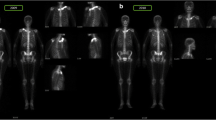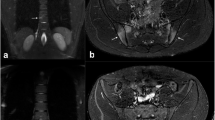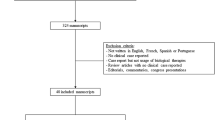Abstract
SAPHO syndrome is a rare entity that compromises the skeletal system (arthritis–osteitis) and is associated with various dermatological conditions such as palmoplantaris pustulosis (PPP) and acne. We present the case of a 39-year-old man with invalidating arthritis derived from a SAPHO syndrome and hypothyroidism (after radioiodine treatment for a Graves’ disease). Due to the severity and refractoriness of his disease, we decided to use infliximab. He showed a prompt and prolonged response of his joint and cutaneous manifestations after three doses of a tumor necrosis factor alpha (TNF-α) blocker. Interestingly, he also decreased his levothyroxine requirements after TNF-α blockade therapy.
Similar content being viewed by others
References
Hayem G, Bouchaaud-Cahbot A, Benali K et al (1999) SAPHO syndrome: a longterm follow-up study of 120 cases. Semin Arthritis Rheum 29:159–171
Wagner AD, Andresen J, Jendro MC et al (2002) Sustained response to tumor necrosis factor alpha-blocking agents in two patients with SAPHO syndrome. Arthritis Rheum 46:1965–1968
Iqbal M, Kolodney M (2005) Acne fulminans with synovitis–acne–pustulosis–hyperostosis–osteitis (SAPHO) syndrome treated with infliximab. J Am Acad Dermatol 52(Suppl 1):S118–120
Olivieri I, Padula A, Ciancio G et al (2003) Persistent efficacy of tumor necrosis factor alpha blockage therapy in SAPHO syndrome: comment on the article by Wagner et al. Arthritis Rheum 48:1467–1468
Olivieri I, Padula A, Ciancio G et al (2002) Successful treatment of SAPHO syndrome with infliximab: report of two cases. Ann Rheum Dis 61:375–376
Massara A, Cavazzini PL, Trotta F (2006) In SAPHO syndrome anti-TNF-therapy may induce persistent amelioration of osteoarticular complaints, but may exacerbate cutaneous manifestations. Rheumatology 45:730–733
Roux CH, Brocq O, Leccia N et al (2007) New-onset psoriatic palmoplantaris pustulosis following infliximab therapy: a class effect? J Rheumatol 34:434–437
Dutz JP (2007) Tumor necrosis factor-α inhibition and palmoplantar pustulosis: Janus-faced therapy? J Rheumatol 34:247–249
Alvaro-Gracia JM, Yu C, Zvaifler NJ et al (1993) Mutual antagonism between interferon-gamma and tumor necrosis factor-alpha on fibroblast-like synoviocytes: paradoxical induction of IFN-gamma and TNF-alpha receptor expression. J Clin Immunol 13:212–218
Pang XP, Hershman JM, Chung M et al (1989) Characterization of tumor necrosis factor-alpha receptors in human and rat thyroid cells and regulation of the receptors by thyrotropin. Endocrinology 125:1783–1788
Bartalena L, Bogazzi F, Brogioni S et al (1998) Role of cytokines in the pathogenesis of the euthyroid sick syndrome. Eur J Endocrinol 138:603–614
Tang KT, Braverman LE, DeVito WJ (1995) Tumor necrosis factor-alpha and interferon-gamma modulate gene expression of type I 5′-deiodinase, thyroid peroxidase, and thyroglobulin in FRTL-5 rat thyroid cells. Endocrinology 136:881–888
Diez JJ, Hernanz A, Medina S et al (2002) Serum concentrations of tumour necrosis factor-alpha (TNF-alpha) and soluble TNF-alpha receptor p55 in patients with hypothyroidism and hyperthyroidism before and after normalization of thyroid function. Clin Endocrinol Oxford 57:515–521
Miyakoshi H, Ohsawa K, Yokoyama H et al (1992) Exacerbation of hypothyroidism following tumor necrosis factor-alpha infusion. Intern Med 31:200–203
Jones BM, Kwok CC, Kung AW (1999) Effect of radioactive iodine therapy on cytokine production in Graves′ disease: transient increases in interleukin-4 (IL-4), IL-6, IL-10, and tumor necrosis factor-alpha, with longer term increases in interferon-gamma production. J Clin Endocrinol Metab 84:4106–4110
Author information
Authors and Affiliations
Corresponding author
Rights and permissions
About this article
Cite this article
Sabugo, F., Liberman, C., Niedmann, J.P. et al. Infliximab can induce a prolonged clinical remission and a decrease in thyroid hormonal requirements in a patient with SAPHO syndrome and hypothyroidism. Clin Rheumatol 27, 533–535 (2008). https://doi.org/10.1007/s10067-007-0767-y
Received:
Revised:
Accepted:
Published:
Issue Date:
DOI: https://doi.org/10.1007/s10067-007-0767-y




